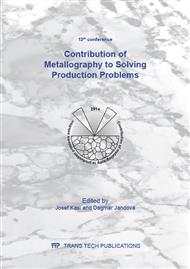p.195
p.205
p.210
p.216
p.222
p.228
p.235
p.243
p.248
Corrosion Resistance of Casings for Metal Detectors in Food Industry Made of Cr-Ni Stainless Steel
Abstract:
The paper discusses the problem of recurrent corrosion of casing of metal detectors used in food industry. The detector casing is fabricated by welding sheets of X5CrNi18-10 stainless steel. The detectors in service suffered non-uniform spot corrosion. The likely cause of the corrosion attack was the accumulated contamination of the detector surface with cleaning and disinfecting agents containing chlorine. The sheet surfaces of the original detectors were shot-blasted. After the sheet finishing process was changed to grinding and minor design changes were made, the corrosion resistance of the detector casing improved. The enhanced corrosion resistance of the detectors with ground surfaces was confirmed by salt spray tests. The use of the modified detectors then led to a lower number of complaints about the devices.
Info:
Periodical:
Pages:
248-254
Citation:
Online since:
May 2015
Authors:
Keywords:
Price:
Сopyright:
© 2015 Trans Tech Publications Ltd. All Rights Reserved
Share:
Citation:


